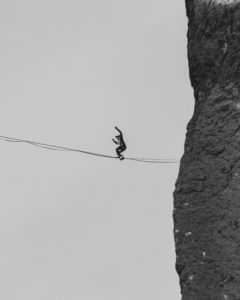Working on the High Wire

Photo by Sean Benesh on Unsplash
Several years ago, I was sitting at lunch with a group of college deans as we interviewed a candidate for the position of Vice President for Business Affairs. The candidate asked us what we liked about the current VP who she knew was both liked and respected on campus. I don’t remember what the deans said, but I do remember what I said. “He isn’t afraid of students.”
I went on to say that I’ve found many administrators who don’t work as regularly with students as we do, seem to be afraid of meeting with students and of facing their often inelegant, but right on-target, questions. I said, “it’s as if they were meeting with a wild animal who they thought might do something strange at any moment.” There was a pause after I said it and I looked at my colleagues and affirmed what I knew they were thinking, “Okay, that’s sort of accurate.” At which point they all laughed. But I was serious and several of them agreed with what I had said. The soon-to-be-leaving VP wasn’t afraid to sit down with students, talk through their questions, answer what he could and honestly admit what he couldn’t share.
Several years ago, after a campus shooting, Gary Pavela wrote an article for The Chronicle of Higher Education with the provocative title “Fearing Our Students Won’t Help Them”. (FYI, this may be behind a paywall. https://www.chronicle.com/article/fearing-our-students-wont-help-them-514/?cid=gen_sign_in.) While some of what Pavela writes about may feel dated – he recommends creating a cross-functional threat assessment team which most campuses have in place – much of what he addresses is still relevant. As we hit April and May which are stressful times in any year and as we return to campuses in the summer and fall, it seems to me it’s worth revisiting. After all, the issues students, faculty, and staff are facing right now and about which they are concerned aren’t any easier than they were the last time we were all on campus. They may, in fact, be more challenging.
A few comments from Pavela’s article:
“Has the time come to dismiss troubled” (and I would add difficult or challenging) “students first and ask questions later? The answer remains no. And the reasons have less to do with concerns about legal and civil liberties than with our primary responsibility to promote safety and security on campus.”
Pavela suggests that when we think the choice is between safety and civil liberties, we are asking the wrong question.
“But is the distinction we’ve been making between safety and all other considerations valid? Ample credible research — including research by law-enforcement agencies — suggests it isn’t. Safety is enhanced when we protect our students’ civil liberties and when we try to find responsible, creative ways to keep them enrolled, rather than creative ways to dismiss them.”
Pavela lists some options for managing this complex balancing act, but the one I want to focus on today is something I like to think Student Affairs staff excel at: “listen(ing) and exercis(ing) discretion. The Secret Service gives high priority in this regard to creating a school ‘culture of ‘two-way listening,’ including ‘listening to feelings, especially those of hurt and pain.’ It merits attention when agencies like the Secret Service start recommending strategies echoing the humanistic goals of college counseling centers. That unusual development suggests that educators have proven, long-established ways to respond effectively to troubled students…”
Pavela ends the article by saying, “But we can’t understand what is within our students’ hearts if our hearts are guided by fear.” Years later in a completely different context, I was saying essentially the same thing to this candidate who was contemplating moving from a different type of organization to higher education. We need campus leaders and administrators who can listen with open minds to challenging questions and with open hearts to the very real pain suffered by the people with whom we work.
As leaders on campus and in other organizations we interact with people every day, some of whom are easy and fun to work with and some of whom are more challenging. We strive to meet their individual needs and understand their specific concerns. When we are able to work with each person as an individual worthy of respect we are able to do our best work and have the best chance of responding appropriately no matter how minor or severe the situation or difficult the question they bring us. It’s a high wire balancing act to be sure, but it’s a critical component of leadership always.
Take care,
Gage
